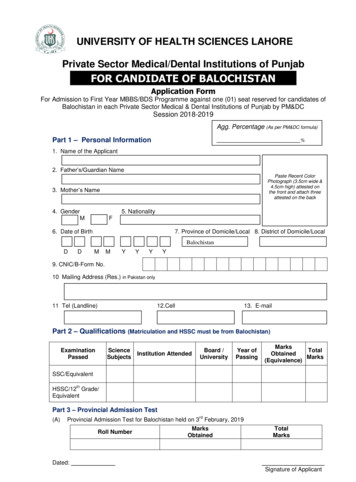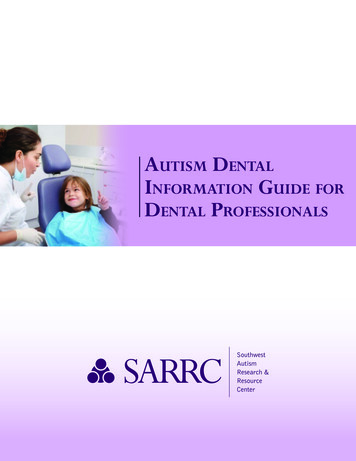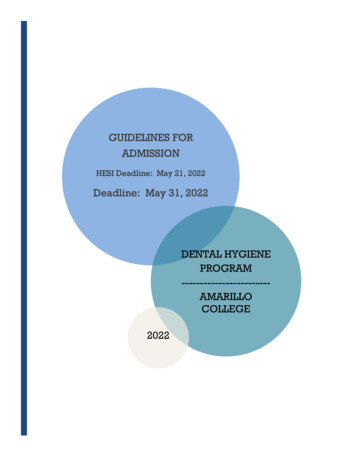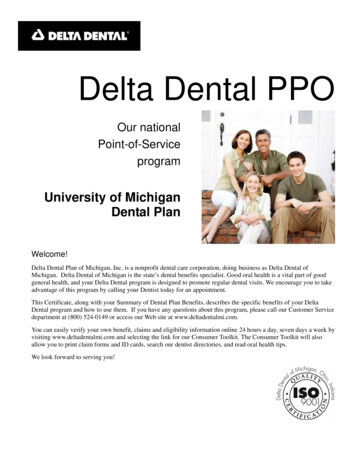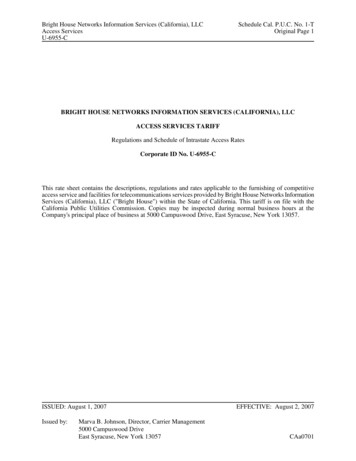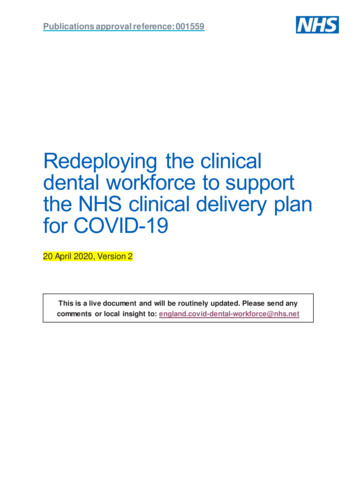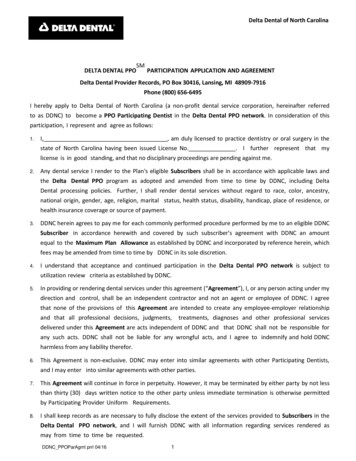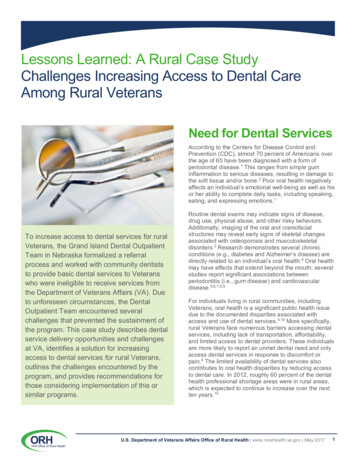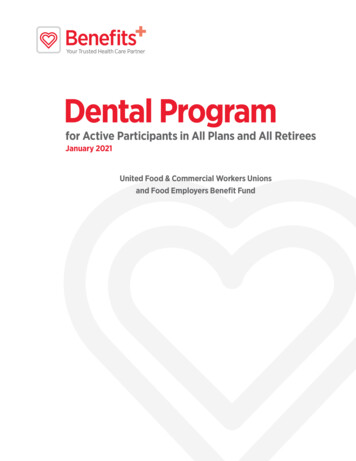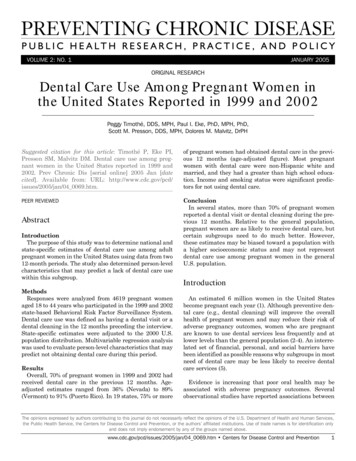
Transcription
VOLUME 2: NO. 1JANUARY 2005ORIGINAL RESEARCHDental Care Use Among Pregnant Women inthe United States Reported in 1999 and 2002Peggy Timothé, DDS, MPH, Paul I. Eke, PhD, MPH, PhD,Scott M. Presson, DDS, MPH, Dolores M. Malvitz, DrPHSuggested citation for this article: Timothé P, Eke PI,Presson SM, Malvitz DM. Dental care use among pregnant women in the United States reported in 1999 and2002. Prev Chronic Dis [serial online] 2005 Jan [datecited]. Available from: URL: http://www.cdc.gov/pcd/issues/2005/jan/04 0069.htm.of pregnant women had obtained dental care in the previous 12 months (age-adjusted figure). Most pregnantwomen with dental care were non-Hispanic white andmarried, and they had a greater than high school education. Income and smoking status were significant predictors for not using dental care.PEER REVIEWEDConclusionIn several states, more than 70% of pregnant womenreported a dental visit or dental cleaning during the previous 12 months. Relative to the general population,pregnant women are as likely to receive dental care, butcertain subgroups need to do much better. However,these estimates may be biased toward a population witha higher socioeconomic status and may not representdental care use among pregnant women in the generalU.S. population.AbstractIntroductionThe purpose of this study was to determine national andstate-specific estimates of dental care use among adultpregnant women in the United States using data from two12-month periods. The study also determined person-levelcharacteristics that may predict a lack of dental care usewithin this subgroup.MethodsResponses were analyzed from 4619 pregnant womenaged 18 to 44 years who participated in the 1999 and 2002state-based Behavioral Risk Factor Surveillance System.Dental care use was defined as having a dental visit or adental cleaning in the 12 months preceding the interview.State-specific estimates were adjusted to the 2000 U.S.population distribution. Multivariable regression analysiswas used to evaluate person-level characteristics that maypredict not obtaining dental care during this period.ResultsOverall, 70% of pregnant women in 1999 and 2002 hadreceived dental care in the previous 12 months. Ageadjusted estimates ranged from 36% (Nevada) to 89%(Vermont) to 91% (Puerto Rico). In 19 states, 75% or moreIntroductionAn estimated 6 million women in the United Statesbecome pregnant each year (1). Although preventive dental care (e.g., dental cleaning) will improve the overallhealth of pregnant women and may reduce their risk ofadverse pregnancy outcomes, women who are pregnantare known to use dental services less frequently and atlower levels than the general population (2-4). An interrelated set of financial, personal, and social barriers havebeen identified as possible reasons why subgroups in mostneed of dental care may be less likely to receive dentalcare services (5).Evidence is increasing that poor oral health may beassociated with adverse pregnancy outcomes. Severalobservational studies have reported associations betweenThe opinions expressed by authors contributing to this journal do not necessarily reflect the opinions of the U.S. Department of Health and Human Services,the Public Health Service, the Centers for Disease Control and Prevention, or the authors’ affiliated institutions. Use of trade names is for identification onlyand does not imply endorsement by any of the groups named above.www.cdc.gov/pcd/issues/2005/jan/04 0069.htm Centers for Disease Control and Prevention1
VOLUME 2: NO. 1JANUARY 2005periodontal infections and increased risk for poor birthoutcomes, such as preterm labor or premature rupture ofmembranes (6-8). These findings are further supportedby experimental animal studies that found maternalexposure to periodontal pathogens resulted in abnormalfetal outcomes (9,10). Preliminary findings from intervention studies also suggest that treatment of advancedperiodontal infections may reduce the risk of adversebirth outcomes (11,12).Currently, information is limited at the national andstate levels on patterns of dental care use, particularlydental cleaning, among pregnant women. The current literature is limited to estimates from five states (Louisiana,Illinois, New Mexico, Arkansas, Washington) participatingin the Pregnancy Risk Assessment Monitoring System(PRAMS); the proportion of new mothers who receiveddental care during their most recent pregnancy rangedfrom 23% to 58% in these five states (13,14).The purpose of the present study was to determinenational and state-specific estimates of dental care use(i.e., having a dental visit or a dental cleaning) duringtwo 12-month periods among pregnant women aged 18 to44 years in the United States. These estimates were generated after combining data obtained in 1999 and 2002by the Behavioral Risk Factor Surveillance System(BRFSS). In addition, this study examined person-levelcharacteristics that predicted not obtaining dental careduring this period.MethodsThe BRFSS is a random, state-based telephone survey ofmajor health risk behaviors, clinical preventive healthpractices, and health care access that relies on a representative sample of noninstitutionalized adults (aged 18) inthe 50 states, District of Columbia, Guam, Puerto Rico,and the U.S. Virgin Islands. Details of the survey areavailable elsewhere (15).All female participants (aged #44 years) in the BRFSSsurvey are asked about their pregnancy status with thequestion, “To your knowledge, are you now pregnant?” In1999 and 2002, three oral health questions were includedin the core module, asked of all participants: 1) “How longhas it been since you last visited the dentist or a dentalclinic for any reason?” 2) “How many of your permanentteeth have been removed because of tooth decay or gumdisease?” and 3) “How long has it been since you had yourteeth cleaned by a dentist or dental hygienist?” In the present study, dental care use was defined as having either adental visit or dental cleaning within the preceding 12months. BRFSS data for 1999 and 2002 were pooled toincrease the samples of pregnant women at the state levels. Analysis was restricted to the dentate, and missingdata or persons not responding to the questions wereremoved from the denominator ( 1%). The average nonresponse rate combined across the various characteristicsexamined in this analysis was 0.80%.Analysis by SUDAAN (Research Triangle Institute,Triangle Park, NC) (16) was used to account for the complex sampling design of the survey and sampling weights.In separate analyses, estimates were age-adjusted basedon the U.S. census population distribution of persons aged 18 years in 2000 (17) to provide a sounder basis for comparing estimates among states (18). Estimates of dentalcare use by pregnant women were stratified by age, levelof education, diabetes status, health insurance status,income, marital status, smoking status, and race/ethnicity(Hispanic is a category of ethnicity that may includewomen of all races). Logistic regression modeling was usedto examine characteristics that were significant predictorsof pregnant women not receiving dental services withinthe preceding 12 months, adjusting for other potentialexplanatory variables. Covariates in the model wereselected a priori based on previous evidence that the variable was associated with dental care use and that measures of the variable were available in BRFSS.ResultsNational and state estimates for dental care use in thepast 12 months among pregnant and nonpregnant dentatewomen are shown in Table 1. The national estimate forpregnant women having a dental visit or cleaning in theprevious 12 months, age-adjusted to the 2000 population,was 70.03% (SE 1.46%), with state percentages rangingfrom 48.32% (Nevada) to 87.02% (Vermont). Estimates fornonpregnant women ranged from 62.77% (Texas) to84.14% (Connecticut). When age-adjusted to the 2000 population, estimates ranged from 36.16% (Nevada) to 91.34%(Puerto Rico). In 19 states, the age-adjusted estimateswere 75% or greater.The opinions expressed by authors contributing to this journal do not necessarily reflect the opinions of the U.S. Department of Health and Human Services,the Public Health Service, the Centers for Disease Control and Prevention, or the authors’ affiliated institutions. Use of trade names is for identification onlyand does not imply endorsement by any of the groups named above.2Centers for Disease Control and Prevention www.cdc.gov/pcd/issues/2005/jan/04 0069.htm
VOLUME 2: NO. 1JANUARY 2005The distribution of age, race/ethnicity, marital status,education, household income, health insurance status, andsmoking status was similar when all pregnant womenwere compared with those receiving dental care in the past12 months (Table 2). Most pregnant women reporting adental visit or cleaning in the preceding 12 months werenon-Hispanic white, married, between the ages of 20 and34 years, and educated beyond high school. In addition,most had health insurance (90.92%, SE 0.91).Compared with pregnant women who received dentalservices, those not receiving dental care were more likelyto be aged 20 to 34 years, be active smokers (smokingevery day or some days), have less than a high school education, and have diabetes (excluding gestational diabetes).These respondents were also less likely to be married andto have health insurance. Pregnant women who reportednot having had dental care in the preceding 12 monthswere twice as likely to lack health insurance and to usepublic health clinics or hospital outpatient services. Inmultivariable logistic modeling, only household incomeand smoking were significant predictors for not reportingdental services in the previous 12 months (Table 3).DiscussionThis study reports the first national and state estimatesfor dental care use during two 12-month periods amongpregnant women in the United States. Estimates wereobtained from a representative sample of pooled data fromthe BRFSS in 1999 and 2002. For most states, the BRFSSis the only source of information on dental care use andrisk factors for chronic diseases. Analyzing this combineddataset, we find about 70% of pregnant women in the U.S.had either a dental visit or a dental cleaning within thepreceding 12 months. This estimate was similar to estimates for the general U.S. population (BRFSS 2002 estimate 70.8%).In the general population, behaviors related to use ofdental care are known to be related to demographic characteristics such as level of education and ethnicity (2,19).Among personal characteristics of pregnant women examined in this study, only income and smoking status weresignificant predictors for not obtaining dental care in theprevious 12 months, suggesting that low-income pregnantwomen may be at higher risk for not receiving dental care.This finding is consistent with reports from PRAMS thatpregnant women receiving no dental care were more likely to use tobacco (14). Because low-income women aremore likely to smoke, smoking in this subpopulation maybe a proxy for low income. Pregnant women who did notreceive dental care were skewed toward a younger age,probably because younger women are more likely to havelower incomes. The BRFSS does not collect information ondental insurance, parity, or perceived fears of harm to thefetus, which are important determinants in whether pregnant women obtain dental care. Previous reports also suggest that low-income pregnant women are less likely thantheir higher-income counterparts to visit the dentist (20).We found that 95% of pregnant women who reported adental visit in the previous 12 months also had a dentalcleaning during that period.State-specific estimates of dental care use in the previous 12 months among pregnant women varied greatly andgenerally followed the dental use pattern of the overallpopulation of women aged 18 to 44 in each state. We foundrelatively higher percentages in states or territories withaggressive preventive dental care programs for pregnantwomen, such as Puerto Rico. Lower estimates for pregnantwomen were seen in states such as Virginia, Nevada, andArkansas and were consistent with lower estimates of dental care use in the general population of these states. It isunclear what factors most influence variation by state.However, the number of community centers with a dentistor dental health program is an important explanatory factor for dental care use among low-socioeconomic status(SES) populations.Importantly, these estimates do not represent the percentage of women reporting dental care use while pregnant. Depending on the term of pregnancy when surveyedby the BRFSS, there would be a period in the 12 monthspreceding the interview when women were not pregnant.Health care providers and dentists treat women differently according to pregnancy status, and pregnant womenseek dental care differently. A relatively higher or lowerpercentage of dental visits or cleaning when not pregnantwould skew these estimates up or down, respectively.Notably, state-specific estimates from this study werehigher than those published previously from the five statesthat participated in PRAMS, which ranged from 23% to58% (11,14). Several factors may account for these differences. First, in PRAMS, questions on use of dental carewere restricted to the period when pregnant. Second, whileThe opinions expressed by authors contributing to this journal do not necessarily reflect the opinions of the U.S. Department of Health and Human Services,the Public Health Service, the Centers for Disease Control and Prevention, or the authors’ affiliated institutions. Use of trade names is for identification onlyand does not imply endorsement by any of the groups named above.www.cdc.gov/pcd/issues/2005/jan/04 0069.htm Centers for Disease Control and Prevention3
VOLUME 2: NO. 1JANUARY 2005the BRFSS included only adults (i.e., those aged 18years), PRAMS includes all pregnant women (i.e., including those 18 years) and over-samples two or three characteristics, typically low SES. Finally, the BRFSS is atelephone survey and probably includes a higher SESpopulation than PRAMS.Some limitations should be noted in the use of theBRFSS to obtain estimates for dental care use amongpregnant women. First, the survey is based on self reports,which can be influenced by recall bias. Self-reported dental care, however, has been found to be a valid measure fordental care use given adequate sample size and studydesign (21). Second, the BRFSS is a telephone survey thatgenerally excludes women without residential phones;therefore, the survey might exclude persons of lower SESor households with only cellular phones. Finally, because arelatively small percentage of women are pregnant at anytime, samples for pregnant women in most states oftenwere small, sometimes less than 50. We pooled data for1999 and 2002 to increase the samples and improve estimate reliability, but even then, samples for Maine,Mississippi, and the District of Columbia were small (lessthan 50), and so estimates from these states may be considered less reliable.Because preventive dental care may reduce risk foradverse pregnancy outcomes, we must assess how current patterns of dental care use among pregnant womencompare with those of the general population. Estimatesfrom this study suggest that dental care use in the previous 12 months among pregnant women is about the samein the general population; in both populations, indicatorsof SES appear to be important predictors of not usingservices for those persons (approximately 30%) who havenot recently had any dental care. However, we note thatlack of health insurance, use of public health clinics, andthe use of hospital outpatient services were twice as likely among pregnant women not reporting dental care. Oneapproach to reduce lack of dental care among pregnantwomen may include providing health insurance.Additionally, health care providers in these health caresettings are more likely to come in contact with pregnantwomen who do not receive dental care. This may presentan opportunity to provide important oral health education to these pregnant women.Barriers to obtaining dental cleaning need to be exploredfurther and be better understood. One approach toaddressing dental care use could involve prenatal and professional education on the importance of dental care andthe adverse effects of smoking during pregnancy. Overall,these estimates provide baseline information on dentalvisits and cleaning among pregnant women in the UnitedStates and may be useful in formulating oral health policies and programs to improve the health and well-being ofpregnant women.Author InformationCorresponding Author: Paul I. Eke, PhD, MPH,Surveillance, Investigations, and Research Team, Divisionof Oral Health (DOH), Centers for Disease Control andPrevention (CDC), 4770 Buford Highway, Mail Stop F-10,Chamblee, GA 30341. Telephone: 770-488-6092. Email:peke@cdc.gov.Author Affiliations: Peggy Timothé, DDS, MPH, formerly research fellow of the Association of Schools of PublicHealth, CDC, Chamblee, Ga; Scott M. Presson, DDS,MPH, Program Services Team, and Dolores M. Malvitz,DrPH, Surveillance, Investigations, and Research Team,DOH, CDC, Chamblee, Ga.References1. Ventura SJ, Mosher WD, Curtin SC, Abma JC,Henshaw S. Trends in pregnancy rates for the UnitedStates, 1976-97: an update. Natl Vital Stat Rep2001;49(4):1-9.2. U.S. Department of Health and Human Services. Oralhealth in America: report of the Surgeon General.Rockville (MD): U.S. Department of Health andHuman Services, National Institute of Dental andCraniofacial Research, National Institutes of Health;2000.3. Bolden AJ, Henry JL, Allukian M. Implications ofaccess, utilization and need for oral health care by lowincome groups and minorities on the dental deliverysystem. J Dent Educ 1993;57(12):888-900.4. Atchison KA, Davidson PL, Nakazono TT.Predisposing, enabling, and need for dental treatmentcharacteristics of ICS-II USA ethnically diversegroups. Adv Denl Res 1997;11 (2):223-34.5. Gilbert GH, Shelton BJ, Chavers LS, Bradford EH Jr.The paradox of dental need in a population-basedThe opinions expressed by authors contributing to this journal do not necessarily reflect the opinions of the U.S. Department of Health and Human Services,the Public Health Service, the Centers for Disease Control and Prevention, or the authors’ affiliated institutions. Use of trade names is for identification onlyand does not imply endorsement by any of the groups named above.4Centers for Disease Control and Prevention www.cdc.gov/pcd/issues/2005/jan/04 0069.htm
VOLUME 2: NO. 1JANUARY 2005study of dentate adults. Med Care 2003;41(1):119-34.6. Offenbacher S, Katz V, Fertik G, Collins J, Boyd D,Maynor G, et al. Periodontal infection as a possiblerisk factor for preterm low birth weight. J Periodontol1996;67(10 Suppl): 1103-13.7. Dasanayake AP. Poor periodontal health of the pregnant women as a risk factor for low birth weight. AnnPeriodontol. 1998;3:206-12.8. Offenbacher S, Beck JD, Lieff S, Slade G. Role of periodontitis in systemic health: spontaneous pretermbirth. J Dent Educ 1998;62(10):852-8.9. Collins JG, Smith MA, Arnold RR, Offenbacher S.Effects of Escherichia coli and Porphyromonas gingivalis lipopolysaccharide on pregnancy outcome in thegolden hamster. Infect Immun 1994;62(10):4652-5.10. Collins JG, Windley HW 3rd, Arnold RR, OffenbacherS. Effects of a Porphyromonas gingivalis infection oninflammatory mediator response and pregnancy outcome in hamsters. Infect Immun 1994;62(10):4356-61.11. Lopez NJ, Smith PC, Gutierrez J. Periodontal therapymay reduce the risk of pre-term low birth weight inwomen with periodontal disease: a randomized controlled trail. J Periodontol 2002;73(8):911-24.12. Jeffcoat MK, Geurs NC, Reddy MS, Cliver SP,Goldenberg RL, Hauth, JC. Periodontal infection andpreterm birth: results of a prospective study. J AmDent Assoc 2001;132:875-80.13. Gaffield ML, Gilbert BJ, Malvitz DM, Romaguera R.Oral health during pregnancy: an analysis of information collected by the pregnancy risk assessment monitoring system. J Am Dent Assoc 2001;132(7):1009-16.14. Lydon-Rochelle M, Krakowiak P, Hujoel P, Peters RM.Dental care use and self-reported dental pregnancyproblems in relation to pregnancy. Am J Public Health2004;94:765-71.15. Mokdad AH, Stroup DF, Giles WH. Public health surveillance for behavioral risk factors in a changing environment: Recommendation from the Behavioral RiskFactor Surveillance Team. Morb Mortal Wkly Rep(RR09);1-12.16. Shah BV, Barnwell BG, Bieler GS. SUDAAN: software for the analysis of correlated data. User’s manual release 7.00. Research Triangle Park (NC):Research Triangle Institute; 1996.17. Perry MJ, Mackun PJ. Population change and distribution: 1990 to 2000. Washington (DC): U.S.Department of Commerce, U.S. Census Bureau; 2001.18. Klein RJ, Schoenborn CA. Age adjustment using the2000 projected U.S. population. Healthy People 2010Stat Notes 2001(20):1-10.19. Gilbert GH, Shah GR, Shelton BJ, Heft MW, BradfordEH, Chavers LS. Racial differences in predictors ofdental care use. Health Serv Res 2002;37:1487-507.20. Mangskau KA, Arrindell B. Pregnancy and oralhealth: utilization of the oral health care system bypregnant women in North Dakota. Northwest Dent1996;75(6):23-8.21. Gilbert GH, Rose JS, Shelton BJ. A prospective studyof the validity of data on self-reported dental visits.Community Dent Oral Epidemiol 2002;30:352-62.The opinions expressed by authors contributing to this journal do not necessarily reflect the opinions of the U.S. Department of Health and Human Services,the Public Health Service, the Centers for Disease Control and Prevention, or the authors’ affiliated institutions. Use of trade names is for identification onlyand does not imply endorsement by any of the groups named above.www.cdc.gov/pcd/issues/2005/jan/04 0069.htm Centers for Disease Control and Prevention5
VOLUME 2: NO. 1JANUARY 2005TablesTable 1. Distribution of Dental Care Use Among U.S. Pregnant Women Aged 18–44, Behavioral Risk Factor SurveillanceSystem, 1999 and 2002StatePregnant, Used Dental Care% (95% Confidence Interval)Pregnant, Used Dental Care (Age- Adjusted)% (95% Confidence Interval)Alabama73.76 (59.5-88.1)72.63 (51.4-93.8)Alaska67.64 (53.3-81.9)65.40 (48.9-81.9)Arizona53.60 (34.0-73.2)48.41 (30.0-66.8)Arkansas60.47 (47.1-73.8)57.07 (27.6-88.0)California75.64 (67.0-84.3)73.15 (63.4-83.0)Colorado67.41 (55.7-79.2)64.66 (51.8-77.6)Connecticut76.86 (66.5-87.2)75.06 (62.0-88.2)Delaware83.38 (70.2-96.5)85.48 (75.7-95.3)District of Columbia85.91 (74.9-96.9)a83.71 (70.8-96.6)aFlorida72.11 (63.1-81.1)46.49 (37.3-55.7)Georgia79.33 (68.7-89.9)82.54 (72.5-92.5)Hawaii72.83 (59.5-86.2)72.77 (57.9-87.7)Idaho70.52 (61.1-79.9)69.91 (53.8-86.0)Illinoisb76.65 (67.0-86.3)75.82 (65.0-86.6)Indiana64.94 (50.2-79.6)56.86 (39.1-74.7)Iowa73.85 (62.3-85.4)77.44 (63.5-91.3)Kansas70.84 (61.4-80.2)73.44 (62.2-84.6)Kentucky70.10 (53.2-87.0)58.46 (40.9-76.1)Louisiana82.93 (75.7-90.2)83.56 (75.4-91.8)Maine79.43 (63.4-95.5)a86.45 (76.3-96.7)aMaryland75.49 (65.1-85.9)73.82 (59.5-88.1)Massachusetts75.06 (66.0-84.1)76.62 (67.6-85.6)Michigan79.73 (70.0-88.7)74.93 (63.5-86.3)Minnesota80.67 (73.6-87.7)81.22 (73.6-88.8)Mississippi67.07 (51.6-82.6)a60.35 (36.7-84.1)aMissouri64.02 (50.7-77.3)64.12 (44.5-83.7)Montana74.67 (60.0-89.4)75.95 (60.3-91.7)Nebraska74.38 (64.6-84.2)80.10 (72.3-87.9)Nevada48.32 (30.3-66.4)36.16 (19.0-53.4)(Continued on next page)The opinions expressed by authors contributing to this journal do not necessarily reflect the opinions of the U.S. Department of Health and Human Services,the Public Health Service, the Centers for Disease Control and Prevention, or the authors’ affiliated institutions. Use of trade names is for identification onlyand does not imply endorsement by any of the groups named above.6Centers for Disease Control and Prevention www.cdc.gov/pcd/issues/2005/jan/04 0069.htm
VOLUME 2: NO. 1JANUARY 2005Table 1. (continued) Distribution of Dental Care Use Among U.S. Pregnant Women Aged 18–44, Behavioral Risk FactorSurveillance System, 1999 and 2002Pregnant, Used Dental Care% (95% Confidence Interval)Pregnant, Used Dental Care (Age- Adjusted)% (95% Confidence Interval)New Hampshire71.06 (55.6-86.5)74.30 (60.8-87.8)New Jersey80.18 (66.9-93.5)81.45 (68.4-94.6)New Mexico63.48 (51.1-75.8)66.35 (49.7-83.1)New York70.97 (59.4-82.5)71.59 (58.7-84.5)North Carolina70.54 (58.0-83.1)77.82 (67.6-88.0)North Dakota73.24 (60.1-86.4)56.43 (36.0-76.8)Ohio75.91 (63.6-88.3)70.35 (53.2-87.6)Oklahoma68.70 (58.9-78.5)64.88 (52.2-77.6)Oregon68.78 (55.6-81.9)64.44 (44.8-84.0)Pennsylvania81.71 (73.5-89.9)83.77 (73.4-94.2)Rhode Island80.25 (67.5-93.0)80.95 (69.4-92.6)South Carolina75.65 (63.7-87.6)83.70 (75.9-91.5)South Dakota73.78 (63.8-83.8)74.91 (63.7-86.1)Tennessee71.76 (59.0-84.5)71.94 (57.4-86.4)Texas66.02 (57.0-75.0)65.27 (52.4-78.2)Utah75.85 (66.1-85.7)66.18 (45.6-86.8)Vermont87.02 (78.6-95.4)89.06 (80.5-97.7)Virginia56.02 (41.3-70.7)51.51 (37.2-65.8)Washington71.73 (62.7-80.7)69.53 (59.3-79.7)West Virginia73.47 (59.8-87.2)77.04 (61.3-92.7)Wisconsin84.42 (74.6-94.2)75.41 (59.5-91.3)Wyoming60.36 (43.3-77.4)58.86 (39.9-77.9)Guamc59.83 (24.2-95.5)a79.58 (61.0-98.2)aPuerto Rico86.31 (77.5-95.1)91.34 (85.8-96.8)Virgin Islandsc72.52 (53.9-91.1)a76.53 (59.1-93.9)aUnited States71.16 (69.0-73.3)70.03 (67.1-72.9)StateaSample size 50.bEstimate based on half of sampled population because the state used the dual questionnaire method.cEstimates from 2002 survey only.The opinions expressed by authors contributing to this journal do not necessarily reflect the opinions of the U.S. Department of Health and Human Services,the Public Health Service, the Centers for Disease Control and Prevention, or the authors’ affiliated institutions. Use of trade names is for identification onlyand does not imply endorsement by any of the groups named above.www.cdc.gov/pcd/issues/2005/jan/04 0069.htm Centers for Disease Control and Prevention7
VOLUME 2: NO. 1JANUARY 2005Table 2. Distribution of Person-level Characteristics for U.S. Pregnant Women Aged 18-44, Behavioral Risk FactorSurveillance System, 1999 and 2002CharacteristicAll% (SE)Age (years)an 4619n 3393n 122618-198.49 (0.87)8.74 (1.06)7.88 (1.53)20-2426.29 (1.19)23.99 (1.36)31.96 (2.37)25-2927.37 (1.05)28.37 (1.27)24.90 (1.85)30-3423.40 (0.99)25.16 (1.22)19.07 (1.64)35-3911.24 (0.74)11.24 (0.84)11.27 (1.53)40-443.20 (0.45)2.50 (0.35)4.92 (1.32)n 2684n 1979n 705Non-Hispanic white60.71 (1.83)62.92 (2.17)55.33 (3.23)Non-Hispanic black11.19 (1.23)10.05 (1.29)13.96 (2.76)Other non-Hispanic6.09 (0.87)5.15 (0.97)8.39 (1.83)Multi non-Hispanic1.49 (0.37)1.60 (0.48)1.23 (0.51)20.51 (1.81)20.27 (2.18)21.09 (3.08)n 4612n 3389n 1223Married71.30 (1.24)73.90 (1.39)64.88 (2.34)Divorced2.97 (0.34)2.17 (0.29)4.94 (0.91)Widowed0.15 (0.06)0.14 (0.08)0.18 (0.10)Separated1.42 (0.23)1.37 (0.24)1.53 (0.55)17.18 (0.99)16.16 (1.14)19.71 (1.96)6.97 (0.76)6.25 (0.79)8.77 (1.54)n 4619n 3393n 1226Less than high school14.47 (1.14)12.64 (1.27)18.99 (2.10)High school28.31 (1.19)27.60 (1.39)30.05 (2.30)Greater than high school57.22 (1.34)59.76 (1.58)50.96 (2.42)n 4055n 2989n 1066 10,0005.25 (0.60)4.95 (0.72)6.01 (1.06)10,000-14,9996.46 (0.81)5.74 (1.02)8.29 (1.30)15,000-19,99910.43 (0.94)9.36 (1.14)13.13 (1.76)20,000-24,9999.75 (0.78)8.57 (0.85)12.73 (1.79)25,000-34,99915.98 (0.97)14.41 (1.05)19.95 (2.11)Race/ethnicityHispanic (includes all races)Marital statusaNever marriedUnmarried coupleEducation levelaAnnual household income ( )aUsed Dental Care% (SE)Did Not Use Dental Care% (SE)The opinions expressed by authors contributing to this journal do not necessarily reflect the opinions of the U.S. Department of Health and Human Services,the Public Health Service, the Centers for Disease Control and Prevention, or the authors’ affiliated institutions. Use of trade names is for identification onlyand does not imply endorsement by any of the groups named above.8Centers for Disease Control and Prevention www.cdc.gov/pcd/issues/2005/jan/04 0069.htm
VOLUME 2: NO. 1JANUARY 2005Table 2. (continued) Distribution of Person-level Characteristics for U.S. Pregnant Women Aged 18-44, Behavioral Risk FactorSurveillance System, 1999 and 2002All% (SE)Used Dental Care% (SE)35,000-49,99917.76 (0.98)18.34 (1.10)16.27 (1.98)50,000-74,99916.84 (0.90)18.84 (1.11)11.77 (1.55)75,000 or more17.54 (0.93)19.79 (1.12)11.84 (1.58)n 4417n 3249n 1168Yes1.08 (0.25)0.75 (0.18)1.91 (0.77)No98.92 (0.25)99.25 (0.18)98.09 (0.77)n 4613n 3390n 1223Yes88.37 (0.84)90.92 (0.91)82.07 (1.84)No11.63 (0.84)9.08 (0.91)17.93 (1.84)n 4612n 3388n 1224Yes (every day)8.74 (0.72)7.82 (0.78)11.02 (1.54)Yes (some days)3.02 (0.42)2.61 (0.49)4.05 (0.83)Former21.66 (1.03)20.93 (1.13)23.46 (2.06)Never66.57 (1.18)68.64 (1.32)61.47 (2.37)n 4617n 3390n 1223CharacteristicDiabetes (not gestational)Health insurance statusaSmoking statusaHealth care accessaDoctor’s officeDid Not Use Dental Care% (SE)74.5 (1.6)79.2 (1.8)61.9 (3.5)Public health clinic8.0 (1.1)6.2 (1.1)12.8 (2.6)Hospital outpatient3.4 (0.9)2.3 (0.5)6.3 (2.9)Hospital emergency room4.3 (0.8)3.7 (0.9)5.9 (1.5)Urgent care center2.7 (0.7)2.6 (0.8)2.9 (0.9)Some other kind of place1.3 (0.5)1.8 (0.4)2.4 (0.8)No usual place3.9 (3.0)3.0 (0.6)6.3 (1.3)aSignificant at P .05, based on chi-square test for independence of association between characteristic and dental care use among pregnant women.The opinions expressed by authors contributing to this journal do not necessarily reflect the opinions of the U.S. Department of Health and Human Services,the Public Health Service, the Centers for Disease Control and Prevention, or the authors’ affiliated institutions. Use of trade names is for identification onlyand does not imply endorsement by any of the groups named above.www.cdc.gov/pcd/issues/2005/jan/04 0069.htm Centers for Disease Control and Prevention9
VOLUME 2: NO. 1JANUARY 2005Table 3. Possible Predictors
women with dental care were non-Hispanic white and married, and they had a greater than high school educa-tion. Income and smoking status were significant predic-tors for not using dental care. Conclusion In several states, more than 70% of pregnant women reported a dental visit or dental cleaning during the pre-vious 12 months.


